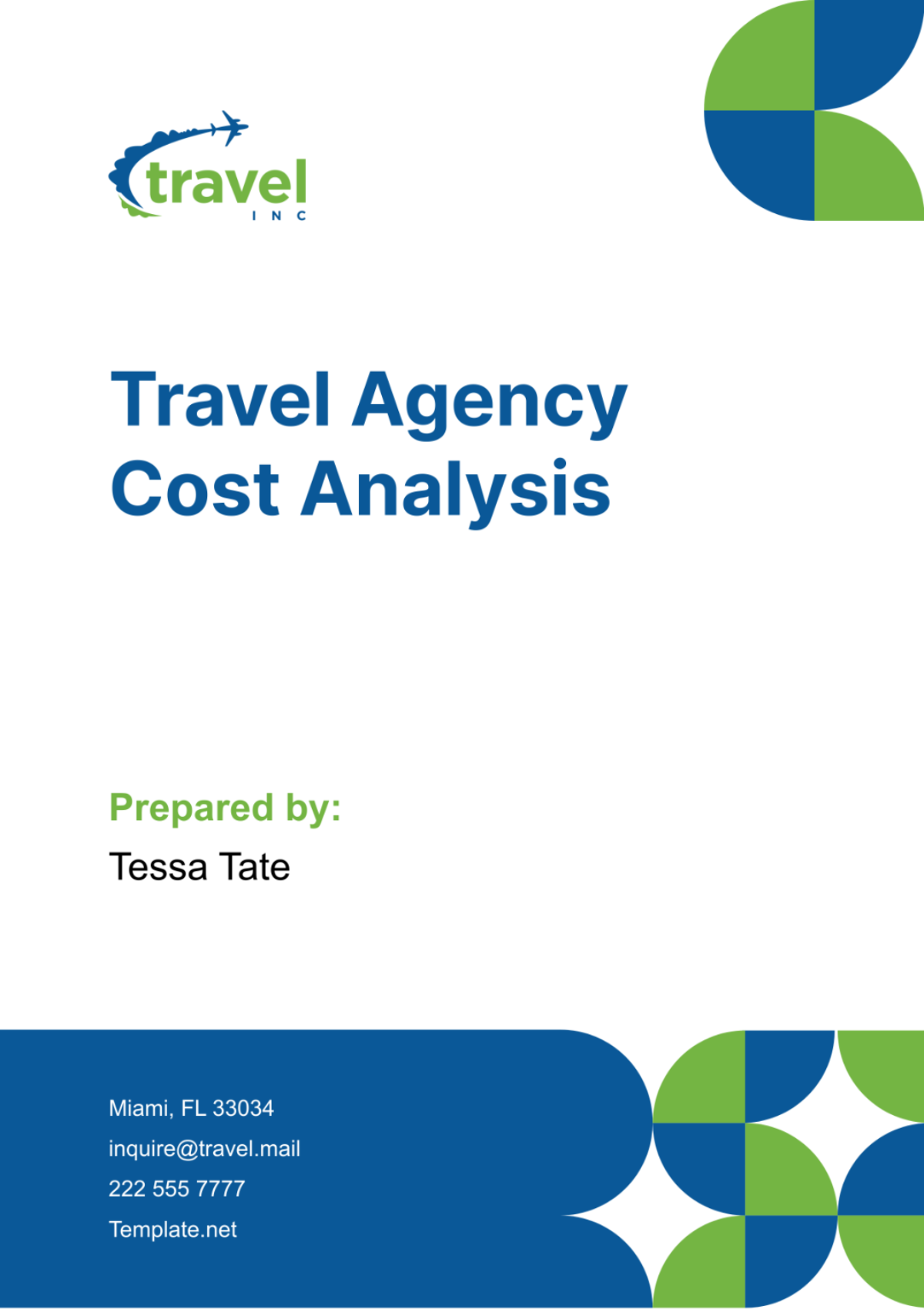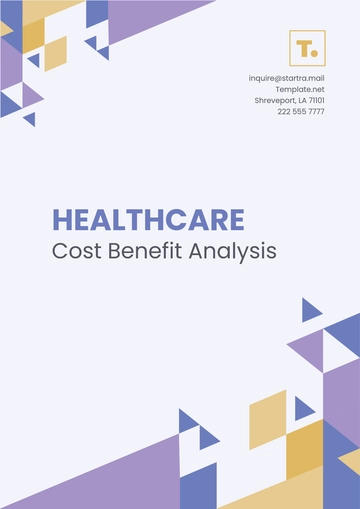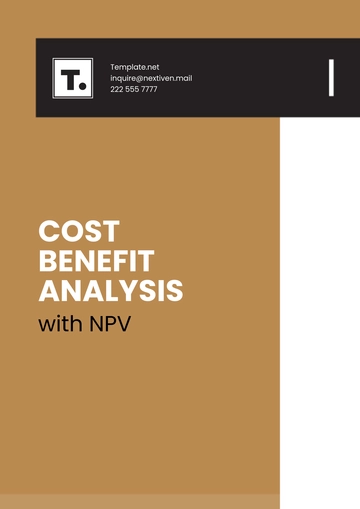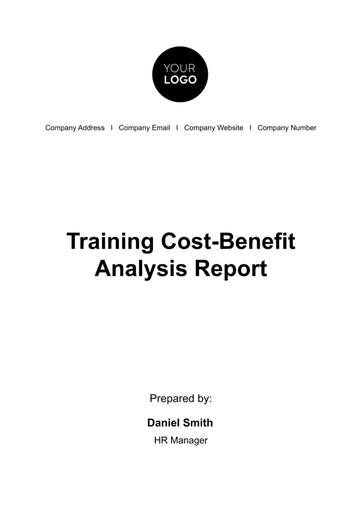Free Travel Agency Cost Analysis

1. Executive Summary
Overview of [Your Company Name]'s Financial Performance
[Your Company Name] has experienced steady revenue growth over the past fiscal year, with a 7% increase compared to the previous year. Despite this positive trend, the profit margins have declined slightly by 3% due to rising operational costs. The analysis provided here seeks to identify key areas where financial adjustments could enhance profitability.
Key Findings from the Cost Analysis
The analysis reveals a significant escalation in variable costs, especially in commission payments and marketing expenses, which surged by 12% and 18% respectively.
Fixed costs have seen a modest increase, primarily due to higher office rent and employee salaries as the company expanded its staff and office space to accommodate growing business needs.
Recommendations for Financial Improvements
Streamlining marketing efforts to focus on high-ROI activities.
Renegotiating vendor contracts to secure better rates.
Implementing cost-saving technologies in daily operations.
2. Company Background
[Your Company Name] was established in [Year] with the vision to provide personalized travel experiences to high-end clients. Over the years, the company has evolved from a traditional brick-and-mortar travel agency into a dynamic blend of online and physical presence, catering to both luxury and corporate markets. The company operates in three major cities and maintains a robust online platform that facilitates over 60% of its bookings.
3. Revenue Analysis
The following table details the revenue streams for [Your Company Name] over the past fiscal year:
Revenue Source | Current Year Revenue | Previous Year Revenue | % Change |
|---|---|---|---|
Ticket Sales | $1.2M | $1.1M | +9% |
Packaged Tours | $2.5M | $2.3M | +8.7% |
Customized Itineraries | $1.8M | $1.5M | +20% |
Miscellaneous | $500K | $450K | +11.1% |
Total | $6M | $5.35M | +12.1% |
Analysis
While total revenue shows a promising increase, the significant growth in customized itineraries suggests a shift in consumer preferences towards more personalized travel options. This shift is a potential area for further development.
4. Cost Structure Analysis
Fixed Costs
Rent or Property Costs: With expansions in office spaces in key markets, rent expenses have gone up by 5%.
Salaries and Wages: Increased by 8% due to hiring additional staff to support business growth and customer service enhancements.
Utilities and Office Maintenance: Relatively stable with a marginal increase of 2%.
Variable Costs
Commission Expenses: Rose by 12%, aligning with increased sales volume.
Marketing and Advertising: Increased by 18% with a strategic push to attract new customers through digital marketing and social media campaigns.
Transaction Fees: Increased by 10% due to higher sales processed through online platforms.
The following table provides a breakdown of key cost components:
Cost Category | Current Year Costs | Previous Year Costs | % Change |
|---|---|---|---|
Fixed Costs | $2M | $1.8M | +11% |
Variable Costs | $1.5M | $1.2M | +25% |
Total Costs | $3.5M | $3M | +16.7% |
Analysis
The increase in variable costs, particularly in marketing and commissions, directly correlates with efforts to expand market reach and increase sales. However, the proportional increase in costs has surpassed revenue growth, squeezing the profit margins.
5. Operational Efficiency
Labor Efficiency
The average revenue per employee stands at $200K, which is a 5% increase from the previous year. This improvement indicates effective use of human resources, though there's room for further efficiency gains through training and better resource management.
Technology Use and Automation
[Your Company Name] has invested in an upgraded booking system and customer relationship management (CRM) software this year. These investments are intended to reduce manual labor, minimize errors, and improve customer service, with the expected break-even point within two years.
Vendor and Partnership Analysis
Regular reviews of vendor performance and costs have allowed [Your Company Name] to maintain a competitive edge by securing cost-effective services and products. The company has recently renegotiated several key contracts, resulting in a 5% reduction in operational costs from these partnerships.
6. Marketing and Customer Acquisition Costs
Advertising Spend Breakdown
[Your Company Name] has allocated significant resources towards advertising, focusing primarily on digital channels due to the higher ROI and tracking capabilities. The following table illustrates the distribution and performance of the advertising budget:
Marketing Channel | Budget Allocation | Last Year Budget | % Change | ROI |
|---|---|---|---|---|
Social Media | $300,000 | $250,000 | +20% | 130% |
Google Ads | $250,000 | $200,000 | +25% | 120% |
Print Media | $50,000 | $80,000 | -37.5% | 90% |
Email Marketing | $100,000 | $90,000 | +11.1% | 150% |
Total | $700,000 | $620,000 | +12.9% | 125% |
Customer Acquisition Cost (CAC)
The Customer Acquisition Cost has been a crucial metric for evaluating the efficiency of our marketing strategies. Currently, the CAC stands at:
CAC Calculation: Total Marketing Spend / Number of New Customers Acquired
Current CAC: $700,000 / 4,600 = $152 per customer
Previous CAC: $620,000 / 3,500 = $177 per customer
This indicates a successful year in marketing efficiency, showing a decrease in CAC and an increase in the number of new customers.
Return on Marketing Investment (ROMI)
The overall Return on Marketing Investment (ROMI) based on net profit from new customers and marketing spending is calculated as follows:
ROMI Formula: (Net Profit from New Customers - Marketing Spend) / Marketing Spend
Current ROMI: 25%, indicating a profitable marketing strategy, particularly through digital and email marketing channels.
Effectiveness of Marketing Channels
Our comprehensive analysis indicates that among various marketing strategies, email marketing and social media platforms offer the highest returns on investment. Based on these findings, we recommend considering a strategic reallocation of resources towards these channels as this shift is likely to enhance future revenue streams.
7. Competitive Analysis
Overview of Key Competitors
[Your Company Name] faces competition from both large-scale online travel agencies and specialized boutique firms. Key competitors include companies like "[Competitor 1]" and "[Competitor 2]," which compete on pricing and unique offerings, respectively.
Competitive Pricing Strategies
Our pricing analysis has shown that while [Your Company Name] offers competitive rates for standard travel packages, there is a need to review the pricing of customized itineraries to ensure they remain attractive yet profitable.
Market Positioning and Differentiation
[Your Company Name] differentiates itself through high-quality, customizable travel experiences and exceptional customer service. Maintaining this edge requires ongoing innovation and customer engagement strategies.
8. Regulatory and Legal Costs
Compliance Costs
[Your Company Name] operates in multiple jurisdictions and thus faces diverse regulatory requirements, including licensure and consumer protection laws. The costs associated with maintaining compliance in these areas are significant:
Regulation Area | Annual Costs | % of Total Compliance Costs |
|---|---|---|
Licensure | $30,000 | 30% |
Consumer Protection | $40,000 | 40% |
Data Protection | $30,000 | 30% |
Total | $100,000 | 100% |
Legal Fees
Legal expenses related to contract negotiations, disputes, and other matters have averaged $50,000 annually.
Insurance Costs
Insurance coverage, including liability and property insurance, costs the company approximately $80,000 per year.
9. Risk Analysis
Identification of Major Financial Risks
Market Risk: Economic downturns can significantly affect travel spending.
Operational Risk: Failures in service delivery can impact reputation and customer loyalty.
Credit Risk: Potential defaults on payments from corporate clients.
Strategies for Risk Mitigation
Key strategies to effectively mitigate these risks involve several crucial approaches. Firstly, diversifying revenue streams can help ensure financial stability by reducing dependency on a single source of income. Secondly, enhancing training for employees involved in customer service is critical to boosting satisfaction and loyalty among consumers. Lastly, improving measures for controlling and managing credit will contribute to robust financial health by minimizing the risk of defaults and bad debts.
10. Future Outlook and Strategic Recommendations
Forecast of Future Costs and Potential Market Changes
Anticipated changes in the travel industry, including increased competition and potential economic shifts, could impact costs and demand. Projections for the next fiscal year suggest a 5-10% increase in overall costs due to inflation and increased marketing spending.
Recommendations for Cost Reduction and Efficiency Improvement
Adopting more advanced automation technologies.
Focusing marketing efforts on high-efficiency channels.
Streamlining supplier and vendor contracts.
Strategic Initiatives for Growth
It is recommended that for the purpose of driving future growth, companies should focus on exploring emerging markets, investing in environmentally friendly travel packages, and enhancing their initiatives in digital transformation.
11. Conclusion
This detailed cost analysis of [Your Company Name] highlights both the challenges and opportunities faced by the company. By implementing the recommended strategic initiatives and maintaining a focus on operational efficiency and marketing effectiveness, [Your Company Name] can enhance its market position and achieve sustainable profitability.
- 100% Customizable, free editor
- Access 1 Million+ Templates, photo’s & graphics
- Download or share as a template
- Click and replace photos, graphics, text, backgrounds
- Resize, crop, AI write & more
- Access advanced editor
Streamline your budgeting process with Template.net's Travel Agency Cost Analysis Template. This indispensable tool, fully customizable and editable via our AI Editor Tool, provides comprehensive insights into your travel services' costs. Enhance cost efficiency and competitiveness by making well-informed financial decisions that align with your agency’s strategic goals. Essential for every travel agency.





























